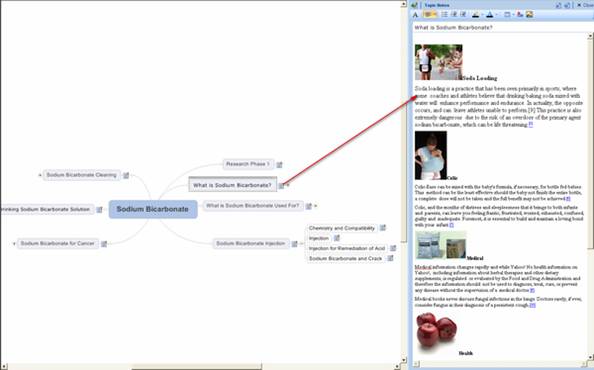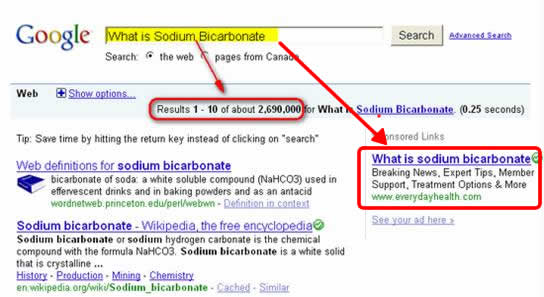Sodium Bicarbonate
Research
Learn how this information was created so you can make better choices with your health. This collection of information has been prepared for purley educational purposes.
Map of Information
A couple of weeks before making this library I began learning about sodium bicarbonate and the many uses it has. I used a combination of online resources, software programs and books that I read to write a few sodium bicarbonate articles. Most of the information I absorbed lead in the same direction with good scientific analysis and descriptions. So I decided to drill deeper into this amazing mineral. However, when I entered into one of the hottest topics within the sodium bicarbonate keyword market I was surprised at the "table chair throwing" and differences in opinion. “Sodium bicarbonate cures cancer” or “Don’t believe what you read about Sodium bicarbonate and cancer”
As an online researcher, author and strategist I thought I would put my tools and mind to work here. How much can I learn about Sodium Bicarbonate and how well can I explain it to you?
Challenges
- What topics are being discussed around the subject? On blogs, forums, scholar, groups and search engines whats’ the buzz?
- It was difficult online to truly depend on the source of information. This is especially applicable when you are looking for advice on injecting it into your bloodstream or any health related condition. During my early bicarb research efforts I found it difficult to form an honest opinion on its ability to cure cancer.
- Because there is a problem verifying authenticity of some sources it causes problems organizing and consolidating a trustworthy data set of information that is deemed trustworthy.
- Many blog and web articles I read were not focused and content covered many topics that were not on my list of curiosity.
- I found it was a task to go from layman’s content and jump right into technical terms. Articles structured with the laymen’s intro (not many) then technical were more meaningful to me.
- It was sometimes tough and time consuming to separate the reliable information from the non-reliable information.
- Following and reading opinion threads became clouded with interest and not fact. If you follow an opinion (Forum, blog, etc) and it’s wrong so is your understanding and reporting.
- Some content had a high frequency of editing, some was static, and some were dynamic articles.
- Specific details on a topic were more difficult to find with Google search.
- How big is a market? If there is no market for your idea, blazing new trials is expensive, time consuming, highly strategic and good luck. Having knowledge of each market helps you find the money.
The Solutions
- By visiting blogs, forums, scholar groups, groups and search engines we can learn about any topic. It is enlightening, educational and incredibly time consuming. A few years ago, that’s the way we did it. Researching a market thoroughly to formulate the master plan would take weeks or months to dig in the trenches. To find out what the buzz is today, it’s all about software and APPS. And so, in this project I have used software that has been programmed for this purpose.
Enter The Main Keyword

Immediately find the Hottest Topics
Buzzing

With this list of theme keywords I am going to build a theme cluster of information. The topics I will discuss are listed in solution [3].
- How does one determine an authority in a given subject? Ask Google! For those that study Google search you know that one of the algorithms they rely on for search results is the authority centric algorithm. To find experts we will use Google’s technology integrated into another application. I will also use the source options available. I will query Google, blogs, MSN, Yahoo, article sites, us govt, news, and news archives.
Drilldown Every Keyword

- Following the recipe above [2] we will allow software and the programming to do what is was programmed for- find targeted information from experts. The screenshot above shows how we collect information.
Based on our research so far here are the subjects I am going to collect information on via software. Then I will digest the information to create my research articles.
- Using a software system of data collection, where each keyword and phrase is analyzed for context, we can create all content. This content is rich theme content as written by me and cited by each author otherwise. We will control the output right from the start using mind mapping software that will output html.
Content Map Overview
-

Expanded Category View

- In a sense, each article is an article of articles. This paints each subject with a wider brush. If there is a part of an article you don’t understand, move on to the next title. If you like what you read click the citation link (when cited) to expand your knowledge.
- I do not think trustworthy and non trustworthy sites can be sorted out 100% algorithmically. Human intervention is needed. In this case we use software combined with human intelligence (research, review and verify). In each topic we also add the relevant imagery. If you click the images you will be taken to the human verified source. All content generated has also been checked and verified using human review and summary.
- Each chosen content block has gone through a quality score system that we use, scanned by human eyes, and left in its (topic) algorithmic state. Each result is determined by native software, humans and Google’s ranking algorithms.
- A simple monthly cache date comparison over the last 12 months shows us if the document changed (software). Documents that read nicely (human scan) and had less changes represented higher authority and permanence.
- By compiling a source of highly related citations, people that really want to explore markets or learn about subjects will find a more refined fetch of information.
- Verifying the (keyword) market size is performed manually or by software. The manual process is quite simple.
Keyword Market Size- Example A

Keyword Market Size-Example B

In this case Example A is a bigger market. Software simply automates this process.
Our Goal
The goal of this project is to compile a more specific data set of information on any given topic. Our guinea pig project uses the term sodium bicarbonate as a central topic. Each category and article within each category will directly relate to human thought processing (part of software programming). Practical applications for this multi-software, content purification research process include the following:
- Market researchers requiring a library of a market data to learn, conceptualize and build with.
- Websites that supply content and want expert verbiage (quotes) integrated in their content.
- Fact library additions to existing websites.
- Find low hanging fruit in any market.
- Prove we can create valuable content on any given topic.
Consumers
This system was originally designed with a few types of consumers in mind.
- Website Developers- looking for an exploited view of any market before they build a website. This harmonized system outputs directly to the web with a number of pre-designed themes. With full navigation into your focused market ideas in structure, keyword triggers and context become very clear.
- Marketing Researchers- looking for an authority’s library of expert knowledge on any subject.
- Content Writers- creating information on a topic. A way to quickly learn about closely realted topics. Who are the experts? What do they say?
|

